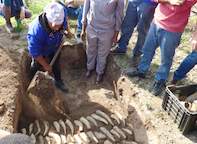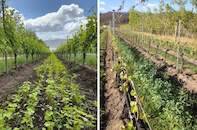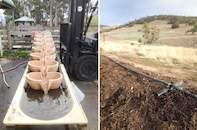Biodynamic farming is different from other organic farming systems in that it combines farming actions with the spiritual science or ‘anthroposophy’. In addition, biodynamic farming also uses nine biodynamic preparations (BD preparations) to enrich biodynamic compost, enhance soil quality and stimulate plant and microbial life.

In fact, many proponents of biodynamic farming feel that BD preparations and biodynamic compost are the cornerstones of this farming system.
The biodynamic approach to farming sees the farm or garden as a living organism comprising many elements, all interdependent on each other. These elements include the fields, plants, animals, people and even the soil and compost, as well as the ‘spirit of the place’.
How did Biodynamic Farming Start?
The originator of biodynamic farming, the Austrian scientist and philosopher Dr Rudolf Steiner, started the biodynamic farming methodology in the 1920s. In a series of eight lectures, he urged farmers to combine a scientific understanding of farming with the spirit and elements in nature.
Dr Steiner maintained that for the healthy development of all the elements of a farming enterprise - that includes farmers and workers themselves - the conscious involvement of all forces, even the unseen ones such as the spirit of the place and lunar cycles, need to be enlisted in a practical way.
Thus, in modern farming, this means a diversion from the scientific mechanistic and materialist to a more holistic approach. This holistic attitude to farming incorporates all aspects and elements, reintegrate plant, animal and human to re-create the farm/garden into a well-balanced organism.
On a practical level: seen from this biodynamic perspective, pests, diseases and weeds are indicators that show that the balance in the system (or organism) is disturbed. Managing these ‘pests’ should rather focus on finding and adjusting the imbalance.
Biodynamic Farming in Practice

Alan Rosenberg, agricultural writer and mentor with South Africa’s National Department of Agricultural has included some practical applications of biodynamic farming in his book ‘Biodynamic Agriculture, a Conscious Choice’. In order to restore the farm to a well-balanced entity, there is a focus on plant diversity (to encourage soil life), a variety of animals (for organic manuring) and a thorough understanding of the environmental implications of farming.
He maintains biodynamic activities must include cover cropping, crop rotation and biodynamic composting using specific preparations.
Biodynamic farming uses the cycles of the moon and stars to determine the optimum dates for planting, harvesting and other farming activities. To do this, farmers consult a lunar calendar for the specific date on which they plan a farming activity.
For example, pruning to slow down growth in mature trees are more effective during the waning moon phase - when the moon is becoming less bright. Planting of root crops such as beets and carrots is said to be better when the moon is full as the stronger gravitational pull creates more moisture in the soil.
Biodynamic Preparations

Dr Steiner has developed nine biodynamic preparations named BD 500 to BD 508. These BD preparations help regulate biological processes and enhance and strengthen life (etheric) forces. BD preparations are made from various organic materials (e.g. cow manure or stinging nettle) used as foliar or soil sprays or in specific positions in a compost heap to enrich compost.
BD 500, for example, is made from cow manure that was fermented in a cow horn buried in the soil for six months through autumn and winter. BD 500 is used as a soil spray to stimulate root growth and humus formation.
BD 508, made from the silica-rich horsetail plant (Equisetum arvense) is used as a foliar spray to suppress fungal growth.
Biodynamic Certification
Certification of biodynamic farms and gardens are managed by Demeter International, for which the standards were established in 1928.
Biodynamic certification looks at the whole farm, not just a specific crop and, as such, only a whole farm is certified. Biodynamic certification ensures crops and livestock are integrated, animals are treated humanely, imported breeding stock is kept to a minimum and that BD preparations are timeously applied.
In addition, biodynamic certification requires that half the feed needed for animals are grown on the farm and a minimum of 10% of the total farm is allocated to encourage biodiversity. The biodynamic farm should also uphold standards of social responsibility to resources and humans.
The non-profit organisation Biodynamic Agricultural Association Southern Africa (BDAASA) is based in Stellenbosch and supports and develops biodynamic farmers through knowledge and connection.
By Marinda Louw